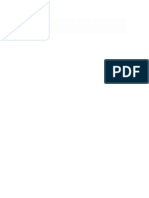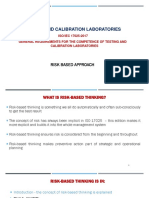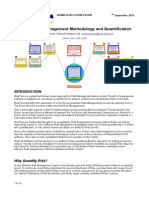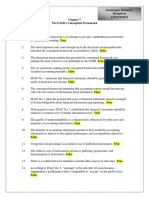1.17 Ac15 Sample Size Table - 7540-05
1.17 Ac15 Sample Size Table - 7540-05
Uploaded by
Huon HirikaCopyright:
Available Formats
1.17 Ac15 Sample Size Table - 7540-05
1.17 Ac15 Sample Size Table - 7540-05
Uploaded by
Huon HirikaCopyright
Available Formats
Share this document
Did you find this document useful?
Is this content inappropriate?
Copyright:
Available Formats
1.17 Ac15 Sample Size Table - 7540-05
1.17 Ac15 Sample Size Table - 7540-05
Uploaded by
Huon HirikaCopyright:
Available Formats
Appendix 1.
17
Ac15/1
Prepared by:LKM Date:
Client: ABC Organisation
Reviewed byRTY Date:
Period: 31-Dec-20
AUDIT APPROACH AND SAMPLE SIZE CALCULATION
To complete the table below enter the risk level as per Ac10 and the materiality level as documented at Ac13. Where a different risk level is relevant for different assertions the table can be expanded as indicated on the lefthand margin.
The audit approach should be selected by entering 'Y' or 'N' as appropriate. Where sampling is not required under the approach selected the remainder of the row will be greyed out.
Where substantive testing is to be undertaken document whether this will be supported by controls testing or supportive analytical procedures. For each area, enter the population and any large or key items on the appropriate
supporting schedule. The residual sample size will then be automatically calculated by dividing the residual population (after large and key items) by materiality and multiplying this by the risk factor which is determined by the audit
approach as documented on the reference table below.
Where transaction testing is to be undertaken select the approximate number of transactions from the drop down. This together with the risk level entered will calculate the appropriate sample size, again based on the information on the
reference table below.
A B C
General Substantive Transaction
Audit approach (Y/N)
Audit Assertion (1) Value of
(Expand if different risks Tests of Supportive Risk population No of material / Approximate Transaction
apply to different Risk per control # analytical factor (as after large and Residual key items to be number of sample size
Audit Area assertions) Ac10 I P % S T (2) @ procedures # below) key items Section Ref sample size tested transactions from table B
High
Opex - 7540-03 All Medium N N n n n n n 0.9 121,873 Ac15/14 16 4
Materiality 6,850
Audit - Mar '20 App. 1.17 / 1 of 15 04/18
Appendix 1.17
Ac15/2
(1) Risk must be assessed for each area at assertion level. If for an area, all assertions have the same risk use the "all" line. However, if there are different levels of risks then the various assertion rows should be
expanded in each area as relevant. At the testing stage the key assertions are occurrence, completeness, accuracy, cut off and classification for transactions and existence, rights and obligations, completeness, valuation
and allocation and disclosure for balances.
(2) If testing controls then the operating effectiveness of the non critical controls must be tested at least every three years to ensure that they are effective, all critical controls should still be tested annually.
Walkthrough tests should be carried out every year to ensure that controls have not changed.
(3) It will usually only be appropriate to test controls where they are expected to be effective therefore a low risk sample size should be used.
Reference Table Balance Sheet Profit or Loss
Audit Approach Risk Level Risk Level
A B C H M L Population H M L
Approach Control AR Risk Factor Size Risk Factor
I,P,% N/A N/A N/A N/A N/A N/A N/A N/A
S** No No 2.5 1.8 1.2 1.2 0.9 0.6
S** Yes No 1.3 0.9 0.6 0.4 0.3 0.2
S** No Yes 1.7 1.2 0.8 0.8 0.6 0.4
S** Yes Yes 0.9 0.6 0.4 0.4 0.3 0.2
Method of obtaining audit evidence Sample Sizes**
T/C N/A N/A N/A N/A N/A > 401 60+ 40 25
T/C N/A N/A N/A N/A N/A 226-400 48+ 32 20
T/C N/A N/A N/A N/A N/A 101-225 36+ 24 15
T/C N/A N/A N/A N/A N/A 26-100 24+ 16 10
T/C N/A N/A N/A N/A N/A 1-25 12+ 8 5
Key
I Less than performance materiality
P Proof in total (extensive analytical procedures)
% 100% testing
S Substantive sampling
T Transaction testing
# If a yes is recorded in either column B or C then suitable testing must be undertaken and the validity of this response must be reviewed at the end of
the fieldwork and it must be cross referenced to supporting working papers
@ It is only possible to record a yes in this column if controls have been tested, and they are effective. If the controls are ineffective, a no must be
recorded in this column. This column may be completed with a yes at the planning stage if it is intended to test controls.
C Tests of control
** When performing substantive procedures, the number of items selected from the residual population (after testing all "large" / "key" items) may be
capped at the levels noted for transaction / control testing.
Audit - Mar '20 App. 1.17 / 2 of 15 04/18
Appendix 1.17
Ac15/3
Intangible Non-Current Assets and Goodwill
CU
Value Per Financial Statements
Less Large Items (to include all items greater than performance materiality)
Name Balance
Less Key Items
Description Reason Balance
Total Large and Key Items
Population after Large and Key Items
Audit - Mar '20 App. 1.17 / 3 of 15 04/18
Appendix 1.17
Ac15/4
Property, Plant and Equipment (Including Investment Properties)
CU
Value Per Financial Statements
Less Large Items (to include all items greater than performance materiality)
Name Balance
Less Key Items
Description Reason Balance
Total Large and Key Items
Population after Large and Key Items
Audit - Mar '20 App. 1.17 / 4 of 15 04/18
Appendix 1.17
Ac15/5
Investments (Excluding Investment Properties)
CU
Value Per Financial Statements
Less Large Items (to include all items greater than performance materiality)
Name Balance
Less Key Items
Description Reason Balance
Total Large and Key Items
Population after Large and Key Items
Audit - Mar '20 App. 1.17 / 5 of 15 04/18
Appendix 1.17
Ac15/6
Inventories
CU
Value Per Financial Statements
Less Large Items (to include all items greater than performance materiality)
Name Balance
Less Key Items
Description Reason Balance
Total Large and Key Items
Population after Large and Key Items
Audit - Mar '20 App. 1.17 / 6 of 15 04/18
Appendix 1.17
Ac15/7
Trade Receivables
CU
Value Per Financial Statements
Less Large Items (to include all items greater than performance materiality)
Name Balance
Less Key Items
Description Reason Balance
Total Large and Key Items
Population after Large and Key Items
Audit - Mar '20 App. 1.17 / 7 of 15 04/18
Appendix 1.17
Ac15/8
Other Receivables
CU
Value Per Financial Statements
Less Large Items (to include all items greater than performance materiality)
Name Balance
Less Key Items
Description Reason Balance
Total Large and Key Items
Population after Large and Key Items
Audit - Mar '20 App. 1.17 / 8 of 15 04/18
Appendix 1.17
Ac15/9
Bank and Cash
CU
Value Per Financial Statements
Less Large Items (to include all items greater than performance materiality)
Name Balance
Less Key Items
Description Reason Balance
Total Large and Key Items
Population after Large and Key Items
Audit - Mar '20 App. 1.17 / 9 of 15 04/18
Appendix 1.17
Ac15/10
Trade Payables
CU
Value Per Financial Statements
Less Large Items (to include all items greater than performance materiality)
Name Balance
Less Key Items
Description Reason Balance
Total Large and Key Items
Population after Large and Key Items
Audit - Mar '20 App. 1.17 / 10 of 15 04/18
Appendix 1.17
Ac15/11
Other Payables
CU
Value Per Financial Statements
Less Large Items (to include all items greater than performance materiality)
Name Balance
Less Key Items
Description Reason Balance
Total Large and Key Items
Population after Large and Key Items
Audit - Mar '20 App. 1.17 / 11 of 15 04/18
Appendix 1.17
Ac15/12
Provisions
CU
Value Per Financial Statements
Less Large Items (to include all items greater than performance materiality)
Name Balance
Less Key Items
Description Reason Balance
Total Large and Key Items
Population after Large and Key Items
Audit - Mar '20 App. 1.17 / 12 of 15 04/18
Appendix 1.17
Ac15/13
Revenue
CU
Value Per Financial Statements
Less Large Items (to include all items greater than performance materiality)
Name Balance
Less Key Items
Description Reason Balance
Total Large and Key Items
Population after Large and Key Items
Audit - Mar '20 App. 1.17 / 13 of 15 04/18
Appendix 1.17
Ac15/14
Costs
CU
Value Per Financial Statements 157,192
Less Large Items (to include all items greater than performance materiality)
Name Balance
3rd Rice distribution to household for COVID19 response 9,131.60
2nd & 3rd Rice distribution to household for COVID19 respo 8,037.21
DSA for CCs for Basic CGC training Phase 2 in SR from 24-2 7,800.00
FCA contribution to CWCC for cash transfer for COVID19 res 10,350.00
Less Key Items
Description Reason Balance
N/A
Total Large and Key Items 35,319
Population after Large and Key Items 121,873
Audit - Mar '20 App. 1.17 / 14 of 15 04/18
Appendix 1.17
Ac15/15
Payroll
CU
Value Per Financial Statements
Less Large Items (to include all items greater than performance materiality)
Name Balance
Less Key Items
Description Reason Balance
Total Large and Key Items
Population after Large and Key Items
Audit - Mar '20 App. 1.17 / 15 of 15 04/18
You might also like
- Assign 6 Option A Excel - 7edDocument18 pagesAssign 6 Option A Excel - 7edFaaiz Yousaf50% (2)
- Hammer Group SeptDec 2023Document5 pagesHammer Group SeptDec 2023Adilah AzamNo ratings yet
- Operational Risk Management: Best Practices in the Financial Services IndustryFrom EverandOperational Risk Management: Best Practices in the Financial Services IndustryNo ratings yet
- HIRA For DPP-2 Project in I BlockDocument20 pagesHIRA For DPP-2 Project in I BlockSiddharth PNo ratings yet
- Risk of Material Misstatement Worksheet - Overview General InstructionsDocument26 pagesRisk of Material Misstatement Worksheet - Overview General InstructionswellawalalasithNo ratings yet
- Risk Assessment For BorescopeDocument14 pagesRisk Assessment For BorescopeJayson Escamillan100% (2)
- Risk & Opportunities EMS 14001: 2015Document23 pagesRisk & Opportunities EMS 14001: 2015Sukhdeep50% (2)
- Assignment 6 The Correct OnesDocument12 pagesAssignment 6 The Correct OnessyafiraNo ratings yet
- Chapter 05Document10 pagesChapter 05Princess Labe100% (1)
- Auditing and Assurance Strathmore University Notes and Revision KitDocument287 pagesAuditing and Assurance Strathmore University Notes and Revision KitAx NgNo ratings yet
- 1.17 Ac15 Sample Size TableDocument15 pages1.17 Ac15 Sample Size TableParbati AcharyaNo ratings yet
- Risk AssesmentDocument1 pageRisk Assesmentshipdesigner088No ratings yet
- Ehs - Hazard Identification and Risk Assessment (Hira) : SL.N oDocument5 pagesEhs - Hazard Identification and Risk Assessment (Hira) : SL.N oNarayanasami KannanNo ratings yet
- Form 18 Sdi 2 - Loans - Risk of Material Misstatement (Romm) WorksheetDocument27 pagesForm 18 Sdi 2 - Loans - Risk of Material Misstatement (Romm) WorksheetwellawalalasithNo ratings yet
- HiraDocument1 pageHirajanisha11No ratings yet
- Project Risk Register Template in ExcelDocument22 pagesProject Risk Register Template in Excelmohamed AMERNo ratings yet
- Form 18 Sdi 4 - Recourse Liabilities - Risk of Material Misstatement (Romm) WorksheetDocument17 pagesForm 18 Sdi 4 - Recourse Liabilities - Risk of Material Misstatement (Romm) WorksheetwellawalalasithNo ratings yet
- Risk Register Template 21Document33 pagesRisk Register Template 21Sead ZejnilovicNo ratings yet
- Q209-04 - ENG Supplier Risk AssessmentDocument30 pagesQ209-04 - ENG Supplier Risk AssessmentDiego MatillaNo ratings yet
- ARCO FP-S - Risk Management Plan Rev BDocument4 pagesARCO FP-S - Risk Management Plan Rev Baplicacionista.imagenesNo ratings yet
- Evaluation Environmental Aspects ActivitywiseDocument4 pagesEvaluation Environmental Aspects ActivitywisePandu BirumakovelaNo ratings yet
- Ac7 Narrative Inherent Risk AssessmentDocument17 pagesAc7 Narrative Inherent Risk AssessmentAndrew PanganibanNo ratings yet
- Direct, Indirect, Routine, Non Routine, Normal, Abnormal, Emergency, Not Applicable, AvailableDocument8 pagesDirect, Indirect, Routine, Non Routine, Normal, Abnormal, Emergency, Not Applicable, Availableg.gohil261No ratings yet
- CMH-17 Priorities and Topics For Chapter 12 Rev. H (NSE)Document19 pagesCMH-17 Priorities and Topics For Chapter 12 Rev. H (NSE)Lukas GneistNo ratings yet
- HIRA FormatDocument2 pagesHIRA FormatSachin Yashwant kumbharNo ratings yet
- A2.20 Economics of Transformer Management 93ID55VER20 PDFDocument47 pagesA2.20 Economics of Transformer Management 93ID55VER20 PDFAbhishek KumarNo ratings yet
- Módulo 9 - ALoSP - enDocument46 pagesMódulo 9 - ALoSP - enKhương Lê DuyNo ratings yet
- Managing The Pay-Off Between Risk, Reliability and Remaining Life - Weighting The ConsequencesDocument11 pagesManaging The Pay-Off Between Risk, Reliability and Remaining Life - Weighting The ConsequencesSiis IngenieriaNo ratings yet
- Banking and Finance - Mortgage Servicing Rights, For The Specified Account. The Substantive Procedures Responsive To The RisksDocument19 pagesBanking and Finance - Mortgage Servicing Rights, For The Specified Account. The Substantive Procedures Responsive To The RiskswellawalalasithNo ratings yet
- AAA Assignment Due 19 AprilDocument7 pagesAAA Assignment Due 19 ApriljasonnumahnalkelNo ratings yet
- Environmental Register Evaluation of Possible Emergencies (FMEA)Document4 pagesEnvironmental Register Evaluation of Possible Emergencies (FMEA)Pandu BirumakovelaNo ratings yet
- Risk Assessment Form - Shifting of Materials From Contractor Yard To New Construction AreaDocument4 pagesRisk Assessment Form - Shifting of Materials From Contractor Yard To New Construction AreakhalidNo ratings yet
- ISS-ABRA-TECH-04 R1 - DG - Preventive Maintenance (Monthly)Document7 pagesISS-ABRA-TECH-04 R1 - DG - Preventive Maintenance (Monthly)Varun GuptaNo ratings yet
- Risk Assessment CalculatorDocument2 pagesRisk Assessment Calculatornale988No ratings yet
- Manual Handling Assessment Charts (The MAC Tool) : What Does The Law Say?Document15 pagesManual Handling Assessment Charts (The MAC Tool) : What Does The Law Say?AbdulKatherNo ratings yet
- A8-RRAALDocument1 pageA8-RRAALlouelaordasNo ratings yet
- Risk Assessment Case Studies:: Summary ReportDocument24 pagesRisk Assessment Case Studies:: Summary ReportEng Mahmoud KhairyNo ratings yet
- Hira Aruisom - 2Document67 pagesHira Aruisom - 2Hemant PatilNo ratings yet
- Risk Management Plan Flowchart - DrawioDocument1 pageRisk Management Plan Flowchart - DrawioAhmed SaeedNo ratings yet
- Form HS05 Risk Assessment enDocument5 pagesForm HS05 Risk Assessment enIbrahim AmerNo ratings yet
- 41R-08 Risk Analysis and Contingency Determination Using Range EstimatingDocument10 pages41R-08 Risk Analysis and Contingency Determination Using Range EstimatingDody Bdg100% (1)
- ISS-ABRA-TECH-29 R1 - ACB - ON & OFF OperationDocument6 pagesISS-ABRA-TECH-29 R1 - ACB - ON & OFF OperationVarun GuptaNo ratings yet
- 002 Fire Risk AssessmentDocument8 pages002 Fire Risk Assessmentasifnawazfarooqi5No ratings yet
- Risk Assessment Modeling in Aviation Safety ManagementDocument7 pagesRisk Assessment Modeling in Aviation Safety ManagementAnnisa RakhmawatiNo ratings yet
- Risk_Register USE THISDocument27 pagesRisk_Register USE THISMarkNo ratings yet
- 07 - Risk Based Approach 17025Document10 pages07 - Risk Based Approach 17025सागर फुकट100% (2)
- Project Risk Register GuidanceDocument8 pagesProject Risk Register GuidanceGabriel LepadatuNo ratings yet
- LTESP SP01 F02 EAI Rev.01Document6 pagesLTESP SP01 F02 EAI Rev.01Gautam PrajapatiNo ratings yet
- 07 JST (S) - 0546-2020Document22 pages07 JST (S) - 0546-2020Romel RodriguezNo ratings yet
- 1.3 PTW Risk AssessmentDocument3 pages1.3 PTW Risk Assessmentrashod champikaNo ratings yet
- RISK Assement AGE-DSV-HIGH SPEED DOOR-30.05.2023Document6 pagesRISK Assement AGE-DSV-HIGH SPEED DOOR-30.05.2023arabiangulfdoorest2008No ratings yet
- Risk Potential Assessment Tool: Resource Management Guide No. 107Document20 pagesRisk Potential Assessment Tool: Resource Management Guide No. 107Mohamed DawesNo ratings yet
- Toc - 41r-08 - Range Risk AnalysisDocument4 pagesToc - 41r-08 - Range Risk AnalysisdeeptiNo ratings yet
- Assessing and Managing Natural Risks at The Panama CanalDocument8 pagesAssessing and Managing Natural Risks at The Panama CanalAMMAR SHABBIRNo ratings yet
- Adfi-Eme-Gfts Ces - Ra-03 - R07 - Water Leakage Test R5 PDFDocument6 pagesAdfi-Eme-Gfts Ces - Ra-03 - R07 - Water Leakage Test R5 PDFIbrahim EsmatNo ratings yet
- Adfi-Eme-Gfts Ces - Ra-03 - R07 - Water Leakage Test R07 PDFDocument6 pagesAdfi-Eme-Gfts Ces - Ra-03 - R07 - Water Leakage Test R07 PDFIbrahim EsmatNo ratings yet
- IRP 22 Risk Register 2015Document29 pagesIRP 22 Risk Register 2015Khuda BukshNo ratings yet
- pmwj27 Oct2014 Wain Updating The Lang Factor Featured Paper PDFDocument17 pagespmwj27 Oct2014 Wain Updating The Lang Factor Featured Paper PDFVictor VazquezNo ratings yet
- Primavera Risk Analysis Risk RegisterDocument59 pagesPrimavera Risk Analysis Risk RegisterKhaled Abdel bakiNo ratings yet
- Bowtie Risk Management Methodology and QuantificationDocument10 pagesBowtie Risk Management Methodology and Quantificationchem_taNo ratings yet
- Team 4 - RiskRegister-TEC431Document2 pagesTeam 4 - RiskRegister-TEC431armstrong amoahNo ratings yet
- Environmental Aspect Impact RegisterDocument17 pagesEnvironmental Aspect Impact Registersyahir et0% (1)
- Q19 - Audit Procedures, Evidence and DocumentationDocument7 pagesQ19 - Audit Procedures, Evidence and Documentationace zero0% (1)
- Module 1 Packet: College OF CommerceDocument14 pagesModule 1 Packet: College OF CommerceCJ GranadaNo ratings yet
- 15 Code of Ethics For Professional Accountants in The PhilippinesDocument11 pages15 Code of Ethics For Professional Accountants in The PhilippinesDia Mae GenerosoNo ratings yet
- Isa 200 Updated July 2022Document33 pagesIsa 200 Updated July 2022tinesa ambikapathyNo ratings yet
- Aa Chap 1Document44 pagesAa Chap 1MichiguyaNo ratings yet
- PwC-IFRS-FS-2020-IFRS - VN - Part 2Document17 pagesPwC-IFRS-FS-2020-IFRS - VN - Part 2Hung LeNo ratings yet
- Conceptual and Regulatory FrameworkDocument10 pagesConceptual and Regulatory FrameworkMohamed Yada AlghaliNo ratings yet
- Audit Process QuestionsDocument18 pagesAudit Process QuestionskesianaNo ratings yet
- (AUDTHEO) Testbank 2Document10 pages(AUDTHEO) Testbank 2ivyaguasarnaldo4everNo ratings yet
- Auditing Theory Material For DLSU Dasma - Batch 24 - Students (0524)Document26 pagesAuditing Theory Material For DLSU Dasma - Batch 24 - Students (0524)Abbey Emmanuelle ValenzuelaNo ratings yet
- Accounting Concepts and Principles - 2020 Online ClassDocument40 pagesAccounting Concepts and Principles - 2020 Online ClassGhillian Mae GuiangNo ratings yet
- Aud FeDocument11 pagesAud FeMark Domingo MendozaNo ratings yet
- Lebanese Association of Certified Public Accountants - Audit February Exam 2020 Extra SessionDocument8 pagesLebanese Association of Certified Public Accountants - Audit February Exam 2020 Extra Sessionjifri syamNo ratings yet
- Chapter 2 NotesDocument5 pagesChapter 2 NotesmatthewNo ratings yet
- Auditing Theory ReviewerDocument19 pagesAuditing Theory ReviewerNathalie PadillaNo ratings yet
- Dominggus Richardo Rampisela Tugas Bab 7Document31 pagesDominggus Richardo Rampisela Tugas Bab 7Dominggus Richardo RampiselaNo ratings yet
- Curro Holdings LTD Annual Integrated Report Ye2017 PDFDocument91 pagesCurro Holdings LTD Annual Integrated Report Ye2017 PDFmdorneanuNo ratings yet
- 3RD Year Diagnostic ExamDocument30 pages3RD Year Diagnostic ExamRoisu De KuriNo ratings yet
- Financial Statements: Kim Nicole M. Reyes, CpaDocument34 pagesFinancial Statements: Kim Nicole M. Reyes, CpaAbby ManilaNo ratings yet
- AAAAudit I Chapter 3Document13 pagesAAAAudit I Chapter 3Mohammed GoseNo ratings yet
- Artigo6 - BrandãoDocument21 pagesArtigo6 - BrandãoJoão GilNo ratings yet
- REVIEWER UFRS (Midterm)Document10 pagesREVIEWER UFRS (Midterm)cynthia karylle natividadNo ratings yet
- Business Accounting Standard - LithuaniaDocument9 pagesBusiness Accounting Standard - Lithuaniafleur de VieNo ratings yet
- Finalterm Examination ACC311-Fundamentals of AuditingDocument9 pagesFinalterm Examination ACC311-Fundamentals of AuditingZeeNo ratings yet
- Auditing Theory Mcqs by Salosagcol With AnswersDocument50 pagesAuditing Theory Mcqs by Salosagcol With AnswersAnthony Koko CarlobosNo ratings yet
- AssignmentDocument3 pagesAssignmentAsra MalikNo ratings yet

























































































